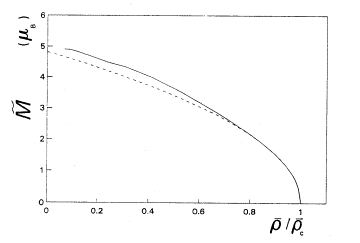
Magnetic properties of metallic dillute alloys
The existence of a local magnetic moment around an impurity in metallic dilute alloys is an old problem. In free electron like hosts the interaction between the impurity atom with the host electrons decreases magnetic magnetic moments of the atoms which in the atomic limit are determined by Hund's rules. A measure of the tendency towards formation of a local moment is given by the critical host electron density rho below which the impurity becomes magnetic.

Magnetic moment as a function of rho for a Mn impurity. The behaviour is described by the equation

|
|
|
Critical densities as a function of the atomic number. Higher density means higher tendency towards magnetism. 3d impurities have the higher tendency for magnetism but even sp elements could become magnetic if diluted in the heavier alkali metals Rb, Cs. The atoms that are above the density of a host metal (horizontal lines) are predicted to be magnetic if diluted in that host. Full lines substitutional defects, dotted lines interstitial defects. |
|
|
Ph. Mavropoulos, N. Papanikolaou, N. Stefanou Phys. Rev. B 58, 1096 (1998)
|
Ενημέρωση 9.2.03 ΝΠ